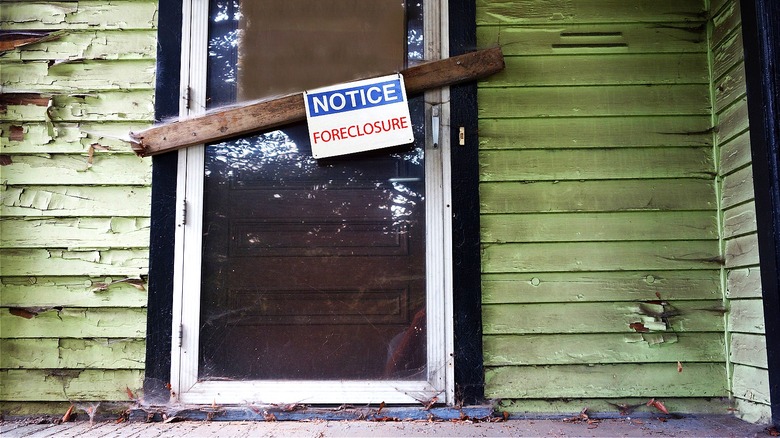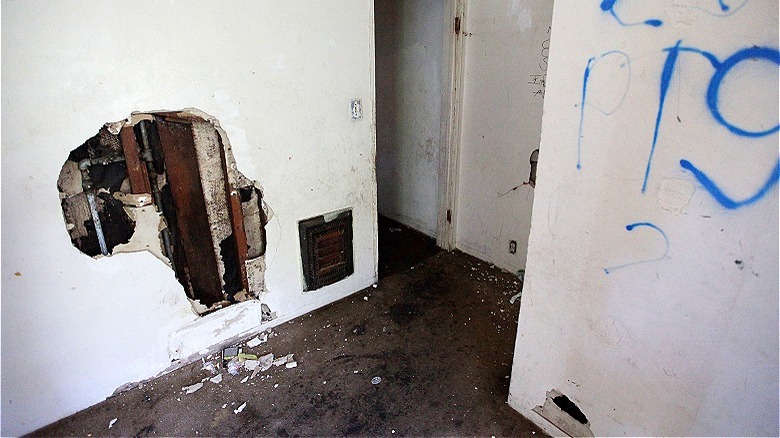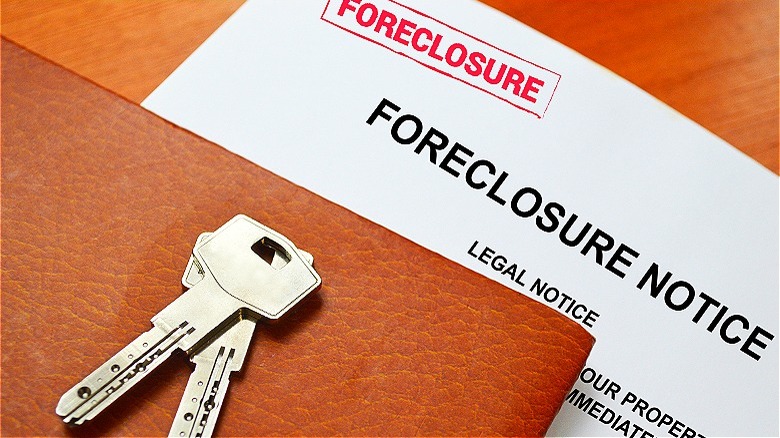What To Consider Before Buying A Foreclosed Home
The Federal Reserve's March 2024 decision to keep interest rates where they are (5.25% to 5.5%) could be making the prospect of buying a new home a financially difficult one. This might leave you looking for more affordable property options that could make the idea of paying in cash, or at the very least require less financing, a possibility. If you've scoured Zillow, chances are you've seen a foreclosed home or two (or more, considering the United States had an 8% increase in foreclosure filings in 2023) that might have left you curious. Often below market rate, foreclosed properties could offer a more financially viable price tag for those looking to buy a home in an increasingly unaffordable market.
For starters, foreclosures typically happen when a borrower defaults on their loan (in this case, a mortgage) or violates other terms of their loan agreement. After a set number of missed payments or violations, the lender that issued (or currently carries) the loan can attempt to recover the amount owed by the defaulted loan. While the exact process for this can vary depending on the state, lenders generally do this by taking ownership of the property and then selling it. Since lenders are usually motivated to get back their loan amount and be done with the process, potential buyers have more negotiating power when it comes to price.
Yet, while foreclosed homes can definitely offer financial positives for buyers, it's important to realize that the process of buying one is more complicated than the typical process of buying from a seller. (See Money Digest's explainer on what it means when something goes into foreclosure.)
The cons of buying a foreclosed home
In February 2024, there were 32,938 properties with foreclosure filings; however, before getting swept away by the price, there are several things to know about purchasing a foreclosed home. For starters, the average foreclosure process in the second quarter of 2023 took 1,212 days (or over three years). This means more paperwork and more waiting before you can move into your new home. It's also worth noting this time frame for the foreclosure process represented a 28% increase over the same time the year before and is also the highest number of days to foreclosure since 2018.
Some other things to consider about purchasing a foreclosed home include the potential for hidden debts, outstanding taxes, and even unpaid liens that you, as the new owner, might be forced to pay. A notable way to avoid this possibility, though, is to purchase a real estate-owned (REO) home (these are lender-owned properties for sale due to the previous owner's default). As always, it's important to run a title search and pursue quality title insurance to help protect you in the event of any potential hidden debts. Not doing such research is one of the things first-time buyers often get wrong about buying a house.
This said, regardless of whether the home is an REO or not, you also face the possibility of damage. Foreclosed homes are sold as-is and, since the previous owners clearly faced financial difficulty with paying for the home, chances are that maintenance and regular care of the property was probably not financially possible. This could mean facing anything from water damage to mold to infestations.
COVID's impact on home foreclosures
The housing mania of 2020 and 2021, resulting from the pandemic, led to a purchasing frenzy that included highly competitive bidding wars, potential buyers waiving home inspections, and a wave of other risky investment decisions. This all led to a significant surge in housing prices, which, post-pandemic, is financially straining buyers today.
Kristen D. Conti, co-chairwoman of Default Industry Leaders, explained the current post-pandemic homeowner struggle to GOBankingRates, "The escalation of prices put many marginal buyers at the very top of their qualifying range. Any change affecting household income can be catastrophic right now as prices become more prevalent and prices decrease." This means those who purchased during the pandemic at the limit of what they could afford then, could be struggling now given the increase in prices for just about everything due to post-pandemic inflation.
This makes the current increase in foreclosure rates across the country (toward pre-pandemic levels) an unfortunate sign of the financial insecurity of many Americans. The high current interest rates are also discouraging buyers from pursuing new homes. This has the potential not only to help stabilize home prices but also potentially impact the rental market as well by creating an increase in available housing. Since most people are avoiding buying due to interest rates, property owners might choose to rent out their properties instead, leading to an increase in inventory. This can be especially helpful in dense competitive markets with housing shortages where rental properties might not be as readily available.


